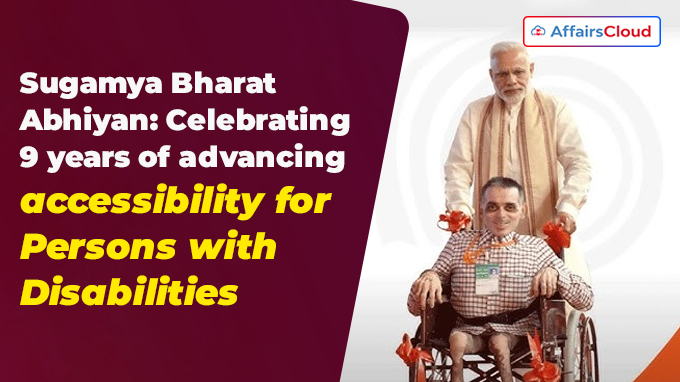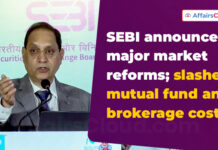 On December 3 2024, Sugamya Bharat Abhiyan, also known as the Accessible India Campaign (AIC), a flagship initiative of Government of India (GoI) for persons with disabilities (PwDs), has completed 9 years of successful implementation.
On December 3 2024, Sugamya Bharat Abhiyan, also known as the Accessible India Campaign (AIC), a flagship initiative of Government of India (GoI) for persons with disabilities (PwDs), has completed 9 years of successful implementation.
- It was launched by Prime Minister (PM) Narendra Modi on 3rd December, 2015, on the occasion of the International Day of Persons with Disabilities(IDPD).
- It is being monitored by the Department of Empowerment of Persons with Disabilities (DEPwD), Ministry of Social Justice and Empowerment (MoSJ&E).
- The primary objective of the campaign is to ensure universal accessibility for PwDs across 3 main domains: built infrastructure, transport systems, and the Information and Communication Technology (ICT) ecosystem.
Background:
i.India is a signatory to the United Nations Convention on the Rights of Persons with Disabilities (UNCRPD) and has pledged to create an accessible environment for PwDs.
- UNCRPD was adopted by the United General Assembly (UNGA) on 13th December 2006. India formally ratified the convention on 1st October 2007.
ii.The AIC is based on a structured approach, which focuses on making public buildings, transport networks like buses and trains, and digital platforms accessible to Divyangjans.
- Initially, AIC was planned to conclude by March 2024, later the core objectives of the campaign have been absorbed into the Creation of Barrier-Free Environment Scheme under the wider umbrella of the Scheme for Implementation of the Rights of Persons with Disabilities Act (SIPDA).
Key Accomplishments :
Over the last 9 years, the AIC has achieved major milestones in creating an inclusive environment for PwDs, by introducing improvements across various sectors like: built infrastructure, transportation, digital platforms, education and media accessibility.
i.Accessibility Infrastructure: So far, 1,671 government buildings were audited for accessibility under the target of auditing 25 to 50 buildings in 50 cities.
- A fund of Rs 562 crore was allocated for retrofitting of 1,314 buildings.
- Accessibility features have been included into 1,748 government buildings, including 648 buildings under State/ Union Territory (UT) governments and 1,100 central government buildings retrofitted by the CPWD.
ii.Transportation: All 35 international airports and among 69 domestic airports, 55 now feature ramps, accessible toilets, helpdesks, and lifts with Braille and auditory systems.
- All international/customs airports provide the facility of aerobridges.
- At present, 709 railway stations have been made fully accessible, while 4,068 stations are partially accessible.
- 8,695 buses (5.96%) out of 1, 45,747 are fully accessible and 42,348 (29.05%) are partially accessible.
- 3,120 out of 3,533 bus stations across 24 states/UTs have been equipped with accessibility features.
iii.Digital Accessibility: 95 central government web portals have been made accessible under the Content Management Framework by the Ministry of Electronics and Information Technology (MeitY).
- 676 state government websites have been made accessible, of which 476 are live.
iv.Education and languages accessibility: The Indian Sign Language Research and Training Centre (ISLRTC) was set up in September 2015 in New Delhi (Delhi), to promote the use, teaching and research of Indian Sign Language (ISL).
- So far, more than 1,013 individuals have been trained in basic ISL through diploma and short-term courses offered by ISLRTC.
- Between 2016-17 and 2023, a total of 183 students have completed the Diploma in Indian Sign Language Interpretation (DISLI) course.
v.Media accessibility: The Ministry of Information & Broadcasting (MoI&B) has released accessibility standards for TV viewing for persons with hearing impairments.
- So far, 19 news channels have telecasted over 2,000 accessible news bulletins and 17 General Entertainment Category (GEC) channels have broadcasted 3,686 accessible programmes and movies.
Key Initiatives:
i.Sector-specific accessibility guidelines: The GoI is working on finalising accessibility standards for the 4 remaining identified sectors: Road Transport and Highways, Tourism, Information and Broadcasting, and Financial Services.
- At present, out of 20 central government ministries/departments, 13 have notified sector-specific guidelines, while 3 have adopted guidelines.
ii.Web accessibility: The DEPwD in partnership with the National Informatics Centre (NIC), is conducting training sessions for officers from central government ministries/ departments to ensure compliance with web accessibility standards.
iii.Training of Access Auditors: The DEPwD in collaboration with Council of Architecture (CoA), has initiated a training program for the expansion of the cadre of certified access auditors.
- The 2nd phase of training for master trainers was organised in July 2024, which resulted in the increase of total number of access auditors to 59.
iv.Sugama Bharat App: It is a crowdsourcing mobile application (app) launched in 2021 by the MoSJ&E, under the AIC to address the issues related to accessibility being faced by Divyangjan (differently-abled).
- Currently, the app is available in 23 Indian languages namely, Hindi, English, Marathi, Tamil, Odia, among others.
- The app has some unique features like font adjustments, colour contrast options, and integrated screen readers in Hindi and English.
v.Curriculum Development: The DEPwD in partnership with Indian Institute of Technology (IIT) Kharagpur, West Bengal (WB), is planning to introduce specialized courses on accessibility in Bachelor of Technology(B.Tech), Bachelor of Planning(B. Plan), and B. Arch programs.
- The GoI held consultations with various stakeholders and their recommendations are being reviewed for inclusion in the model curriculum by AICTE.
vi.Technology and Innovation: At present, over 1,013 airline staff and employees of various public-facing corporate entities were trained in basic ISL. These efforts aim to promote inclusivity in service industries.
vii.Workshops for Universal Accessibility: A training workshop for state Public Works Department (PWD) officers was organised 28th August to 31st August 2023, emphasizing on universal accessibility in built-up environments.
- The session witnessed the participation from representatives of 14 states/UTs.
viii.Web Accessibility Training Program: In collaboration with the NIC, a certified training course on web accessibility is being developed.
- It aimed at providing training to nearly 10,000 web developers across the country and sensitise government departments to adopt and implement Web Accessibility Guidelines.
Financial Support for AIC:
i.Budget Estimates (BE) have progressively increased from Rs 560 crore in 2013-14 to Rs 1,225.15 crore in 2023-24, with Revised Estimates (RE) and Actual Expenditures (AE).
ii.The Government of India (GoI) had spent Rs 1,143.89 crore in 2023-24, representing the highest expenditure in the last 10 years, reflecting the GoI’s focus on achieving universal accessibility and empowerment of persons with disabilities through dedicated campaigns and schemes.
About Ministry of Social Justice and Empowerment (MoSJ&E):
Union Minister- Dr. Virendra Kumar Khatik (Constituency- Tikamgarh, Madhya Pradesh, MP)
Minister of State (MoS)- Ramdas Athawale (Rajya Sabha- Maharashtra); Banwari Lal Verma (Rajya Sabha- Uttar Pradesh, UP )




